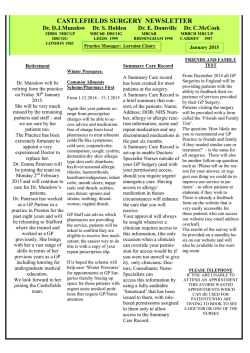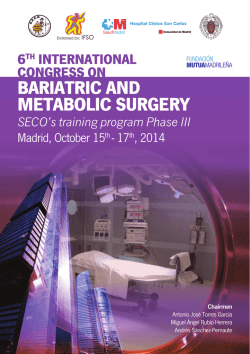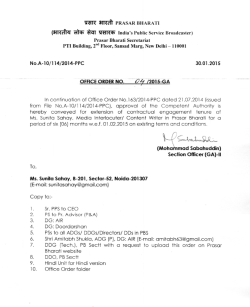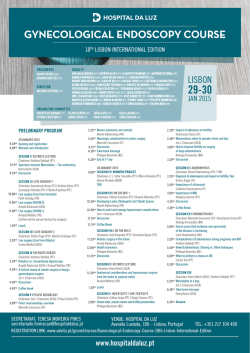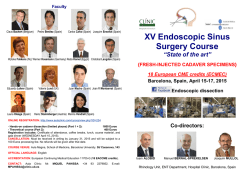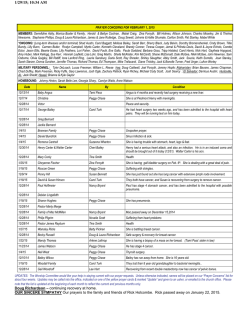
Download - journal of evolution of medical and dental sciences
DOI: 10.14260/jemds/2015/244 CASE REPORT JEJUNO-GASTRIC INTUSSUSCEPTION: A RARE COMPLICATION OF GASTROJEJUNOSTOMY Sudhir Shinde1, Prashant S. Dorkar2, Rahul Bhushan3, Pankaj Bansode4, Mihir Birnale5 HOW TO CITE THIS ARTICLE: Sudhir Shinde, Prashant S. Dorkar, Rahul Bhushan, Pankaj Bansode, Mihir Birnale. “Jejuno-Gastric Intussusception: A Rare Complication of Gastro-Jejunostomy”. Journal of Evolution of Medical and Dental Sciences 2015; Vol. 4, Issue 10, February 02; Page: 1713-1717, DOI: 10.14260/jemds/2015/244 INTRODUCTION: Jejunogastric intussusception is a rare but potentially very serious complication of gastrectomy or gastroenterostomy described in 1941 by Bozzi.1 Only about 200 cases have been reported in literature to date. Diagnosis of this condition is difficult in most of the cases. To avoid mortality early diagnosis and prompt surgical intervention is mandatory. Since gastrojejunostomy with vagotomy are on a declining trend, it is extremely rare to come across such a complication.2 This paper reports a case of retrograde jejunogastric intussusception in a patient who underwent gastrojejunostomy 20 years back for bleeding peptic ulcer. CASE REPORT: A 65 years old male presented in our hospital with complaints of Epigastric pain since 4-5 days, Vomiting which was initially bilious followed by non bilious foul smelling vomiting since 2 days. 4-5 episodes of Hematemesis. Abdominal examination revealed palpable epigastric lump, firm in consistency, with minimal tenderness. Clinically patient had signs of septic shock- fever, tachycardia, tachypnea and hypotension. Patient was an operated case of Gastrojejunostomy 20 years back for bleeding peptic ulcer and he had taken medical treatment for 6 months postoperatively. Patient was a chronic alcoholic, smoker and tobacco chewer with no other co-morbididties. Patient was shifted immediately for Upper GI endoscopy which revealed Retrograde Jejunogastric Intussusception with gangrenous jejunal loop following which he underwent CT abdomen which confirmed the diagnosis. After initial treatment and resuscitation patient was taken for Exploratory Laparotomy with resection of gangrenous jejunum and revision of gastrojejunostomy. Operative Findings- retrograde intussusception of jejunal loop through the stoma with gangrenous changes. Post operatively patient was managed in the intensive care unit. J of Evolution of Med and Dent Sci/ eISSN- 2278-4802, pISSN- 2278-4748/ Vol. 4/ Issue 10/Feb 02, 2015 Page 1713 DOI: 10.14260/jemds/2015/244 CASE REPORT Fig. 1: Endoscopic Picture- intussuscepted jejunal mass through the stoma and normal gastric mucosa. FIGURE 1 Fig. 2: CT –abdomen showing Retrograde Jejunogastric Intussusception. FIGURE 2 J of Evolution of Med and Dent Sci/ eISSN- 2278-4802, pISSN- 2278-4748/ Vol. 4/ Issue 10/Feb 02, 2015 Page 1714 DOI: 10.14260/jemds/2015/244 CASE REPORT Fig. 3: Intraoperative Photographs: a) Gangrenous intussuscepted jejunal loops. b) Lead point through the stoma on exploration of stomach. c) Revision of gastro jejunal anastomosis. d) Specimen of resected gangrenous jejunum. FIGURE 3 DISCUSSION: Retrograde jejunogastric intussusception is a rare acute abdominal condition where the small bowel loops get intussuscepted/incarcerated and strangulated inside the stomach. Jejunogastric intussusception is a rare but potentially serious complication of gastrojejunostomy and gastrectomy. Wolfer performed the first gastrjejunostomy in 1881and 30 years later Bozzi reported the first jejunogastric intussusception in 1914.1 The 100th case was reported in 1955.3 This complication after partial gastrectomy was first reported by Lundberg in 1922.4 The incidence of jejunogastric intussusception is 3 per 2000 operations approximately after gastric operations. This complication is most commonly observed J of Evolution of Med and Dent Sci/ eISSN- 2278-4802, pISSN- 2278-4748/ Vol. 4/ Issue 10/Feb 02, 2015 Page 1715 DOI: 10.14260/jemds/2015/244 CASE REPORT after Billroth II but can complicate any gastric surgery including Billroth 1 gastrectomy and total gastrectomy.5 The widely accepted anatomical classification proposed by Shackman et al. distinguishes three categories of jejuno gastric intussusception: Type I: Afferent loop intussusception (antegrade); Type II: efferent loop intussusception (Retrograde); Type III: combined form.6 Aetiology is unclear. There are two theories, one is functional and another is mechanical. The most widely accepted one is the disordered motility with functional hyperperistalsis triggered by spasm or hyperacidity Mechanical factor include adhesion, long mesentry, sudden increased abdominal pressure. Polyps or neurofibromatosis have also been proposed as a factor for this condition. Clinically patients with jejunogastric intussusceptions may be divided into two types according to the presentations. Type 1 acute fulminant: onset is usually sudden, presents like proximal intestinal obstruction with colicky or constant upper abdominal pain associated with vomiting and hematemesis (sign of incarceration), left hypochondriac palpable mass (< 50%) and Type 2 chronic intermittent: In chronic form, the symptoms may be roughly similar to the acute form but are milder and transient or sudden and spontaneous. Patients present with nausea, vomiting and intermittent abdominal pain following food and spontaneous reduction is usual in chronic form. The presence of a mobile mass in association with pain and vomiting in a patient who has had a previous gastric surgery is considered virtually pathognomic of acute retrograde intussusception. For diagnosis Upper GI Endoscopy should be the 1st test which will allow direct visualization of the lesion. CT scan is another excellent imaging modality for this condition. A plain x ray abdomen may also help showing a homogeneous density in the left upper quadrant which represent small bowel in stomach. There is no medical treatment for jejunogastric intussusception. Non operative management may help only when there is no evidence of vascular compromise, shock, haematemesis, peritoneal irritation or prolonged obstruction and may be beneficial in Chronic Intermittent form. Emergency surgical intervention is the definitive treatment for incarcerated/strangulated acute intussusception. The surgical options available are reduction of intussusception, resection of gangrenous bowel and revision of anastomosis. Revision of anastomsis means converting an antecolic anastomosis to retrocolic position or changing a Billroth II to Billroth I type. Fixation of the jejunum to adjacent tissue like mesocolon, colon, or stomach may be added to reduce mobility of the jejunum and prevent reccurrence. The reported mortality rate range from 10% for treatment within the first 48 hours to 50% within a 96 hour delay.7 CONCLUSION: Jejunogastric Intussusception is a rare condition. Only about 200 hundred cases have been published after its 1st description in 1914. A high index of suspicion is required for diagnosis of jejunogastric intussusception. Endoscopy is certainly diagnostic in the hands of a person familiar with this rare entity. Early recognition and prompt surgical intervention is the correct way of management where reduction, resection and revision of the anastomosis are done depending on the condition found during operation. J of Evolution of Med and Dent Sci/ eISSN- 2278-4802, pISSN- 2278-4748/ Vol. 4/ Issue 10/Feb 02, 2015 Page 1716 DOI: 10.14260/jemds/2015/244 CASE REPORT REFERENCES: 1. Bozzi E. Annotation. Bull Acad Med 1914; 122: 3-4. 2. Tauro, L.F. et al., 2006. A rare cause of haematemesis: retrograde jejunogastric intussusception. The Journal of the Association of Physicians of India, 54, pp.333–5. 3. Irons H Jr, Lipin R: Jejunogastric intussusception following gastroenterostomy and vagotomy . Anals of Surgery 1955; 141: 541. 4. Mason L. Retrograde junogastric intussusception following gastrectomy. Archieves of Surgery 1960; 81: 485-91. 5. Conklin E, Merkwitz AM: Intussusception, a complication of gastric surgery. Surgery 1965; 57:480-885. 6. Shackman R. Jejunogastric intussusception. British Journal of Surgery 1940; 27: 475-80. 7. Walstad P, Ritter J, Arroz V. Delayed jejunogastric intussusception after gastric surgery: An ever present threat. Am Surg 1972; 38(3):1725. 4. AUTHORS: 1. Sudhir Shinde 2. Prashant S. Dorkar 3. Rahul Bhushan 4. Pankaj Bansode 5. Mihir Birnale PARTICULARS OF CONTRIBUTORS: 1. Associate Professor, Department of General Surgery, Bharati Vidyapeeth University Medical College and Hospital, Pune. 2. Junior Resident III, Department of General Surgery, Bharati Vidyapeeth University Medical College and Hospital, Pune. 3. 2nd Year Junior Resident, Department of General Surgery, Bharati Vidyapeeth University Medical College and Hospital, Pune. 5. 3rd Year Junior Resident, Department of General Surgery, Bharati Vidyapeeth University Medical College and Hospital, Pune. Assistant Professor, Department of General Surgery, Bharati Vidyapeeth University Medical College and Hospital, Pune. NAME ADDRESS EMAIL ID OF THE CORRESPONDING AUTHOR: Dr. Sudhir Shinde, Gurukrupa Niwas, Near Vishwa Gym, Vidyanagar, Katraj-kondhwa Road, Pune- 46. E-mail: [email protected] Date of Submission: 29/12/2014. Date of Peer Review: 30/12/2014. Date of Acceptance: 22/01/2015. Date of Publishing: 02/02/2015. J of Evolution of Med and Dent Sci/ eISSN- 2278-4802, pISSN- 2278-4748/ Vol. 4/ Issue 10/Feb 02, 2015 Page 1717
© Copyright 2025
